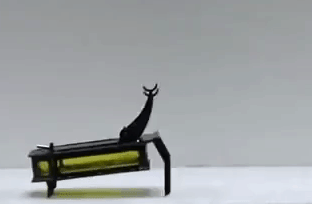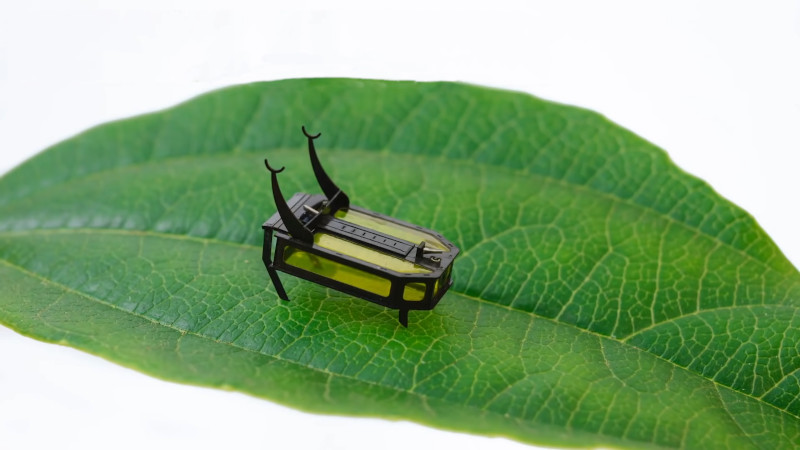Batteries have come a long way in the past few centuries, but pale in comparison to hydrocarbon fuels when it comes to energy density. When it comes to packing plenty of juice in a light, compact package, hydrocarbons are the way to go. Recently, researchers have begun to take advantage of this, powering small robots with liquid fuels. Just like Bending Unit 22, aka Bender Bending Rodriguez, this tiny robotic beetle runs on alcohol.

Affectionately named Robeetle, the tiny ‘bot weighs just 88 milligrams, comparable in mass its insectoid contemporaries. It stores methanol in a polyimide film tank, operating for up to 2 hours on a single fill. As shown in the video, a solely mechanical control system is used to actuate the robot’s legs. In the neutral state, vents in the fuel tank are open, releasing methanol vapor. This passes over nitinol muscle wires coated in a special catalyst which causes the combustion of the methanol, heating the wires. The wires then contract, moving the legs, and closing the vents. When the wire cools, the wires relax, opening the vents and beginning the cycle anew.
While the ‘bot is solely capable of walking in a single direction, it nevertheless shows the possibilities enabled by powering small devices from energy-dense fuels. Waiting for improved battery technologies to develop is such a bore, after all. We look forward to swarms of such ‘bots exploring disaster areas or performing environmental sampling in years to come. The scientific paper outlines the research outcomes in detail.
We love tiny robots at Hackaday; we’ve featured a few in the past, too. Video after the break.















How is this a robot?
It can be outfitted with a control system on its back.
I suppose you could clarify that it is a robot in the making, but anyone needing that wouldn’t have the basic understanding of ‘development’ or what ‘laboratories’ are for, so the distinction would still be lost on them.
Mhh, just because a Delorean can be outfittet with a flux capacitor, that does not make it a time machine (it’s only a car).
Good day.
Obligatory: “You must be fun at parties!” XD
I am, and this isn’t a party.
It kind of was until your comment soured it.
So a car that can travel in time is not a time machine, it’s only a car. OK then.
Not a car that can travel in time, a car that can time-travel. Obviously, time spent is a consequence of travel. He is saying that a car which can move through time directly, independent of travel.
It is ‘travelling in time’.
Only in the same direction, at the same ‘speed’ as everything else.
When you travel in time, you are also travelling in 3D space as the universe isn’t standing still.
[Tekkieneet]
“You’re not thinking 4th dimensionally!”
-Dr. Brown
“Not a car that can travel in time, a car that can time-travel. Obviously, time spent is a consequence of travel. He is saying that a car which can move through time directly, independent of travel.”
Well, English isn’t my first language and this is the Hackday comment section after all. Such pedantic reply was to expected. Time-travel it is then, big deal, as if I did not get what he was saying or indeed anybody here wouldn’t get what *I* was saying.
* was to be expected
It’s mechanically programmed to perform a task. It operates independent of any person controlling it once turned on. Isn’t that what a robot is? What makes nanobots robots? What makes robots robots? I guess your definition of robot is the deciding factor. What’s your definition?
By your definition, clocks and fans are robots, too.
A robot is something significantly more than just a motor. This makes sense:
https://en.wikipedia.org/wiki/Robot
“A robot is a machine—especially one programmable by a computer— capable of carrying out a complex series of actions automatically.”
So a clock is a robot :)
Lets see: It does something automatically? Check. It is a complex machine? Check. It is programmable by at least a human? Check. Sounds like clocks are actually just time robots.
robot: 1920s: from Czech, from robota ‘forced labor’. The term was coined in K. Čapek’s play R.U.R. ‘Rossum’s Universal Robots’ (1920).
I ask myself “how is this a robot” very often. A lot of these research projects, especially at the nano end of things, seem very cool, but not very robotic. Like there was a research project where they moved things around with magnets and called them “robots”.
Snark: whatever brings in the grant money and allows you to make cool things.
But yeah, robot is in the eye of the beholder. I made a draw-bot, and my (then) 5-yr-old son was totally nonplussed b/c he had something with tank treads and humanoid/aluminum tubing arms in mind. You know, a “robot”.
So I won’t get too deep into this one. It’s like arguing about what is and isn’t “barbecue”.
Fantastic answer.
I think your snark is pretty close on point. A “robot” is a bit more amazing than what we’ve got around us regularly. Anything we’ve accepted as part of life, that’s just a machine.
Dishwasher? Amazing robot at some point, now just a “dishwasher”. If you count all the valves and stuff, it’s probably got more degrees of freedom than a CNC.
Robotic vacuum cleaner? We were astounded for a few days, the kids watched it for weeks, but by now it’s needed a battery replacement and it’s just “the Hoover” or “roomba”.
CNC? Was a robot, but now I’ve had it for a while and we’re used to what it makes, not a robot.
Robot arms in car factories? Technically not really different to a CNC, just a few more axis and equipped with a welder. TOTALLY A ROBOT. But I suspect people who work with them see them as mundane and call them “welders” or “production line” or something.
I also would compare this more to an engine than to e robot. It uses fuel, has valves and uses periodic combustion of said fuel to generate motion in exactly one axis / degree of freedom.
It can deliver a small piece of popcorn on its back some distance every 2 hours. It’s doing work without needing constant supervision, that means it’s a robot.
The nitinol wire is barely 2% efficient in converting heat to motion, so it doesn’t actually have an endurance advantage over battery powered robots. For similar output of work, a battery would last days. This one runs for about two hours.
The difference is that tiny batteries can’t put out the power, so any micro-robot which needs high torque or power needs an extension cord.
I’ve seen people running on alcohol that were moving exactly like this.
love it.
We’re they robots?
HEHE Jim
Generally, journalists call everything a robot these days. My definition would be along the lines of “a computational and mechanical device designed to do the work of a man”… yes that is what I would to take as a Robot; at least to some degree, aware of it’s environment and able to adjust its actions accordingly. Thus a food mixer is not, because it is not generally computational (and will cheerfully drag you in), but an automatic welding machine is because it follows a program and will take action if conditions mean it has to (it fouls on something). hmmm my 3D printer becomes a robot… dammit
88 milligram robot. Carries 96 milligrams of fuel. Runs for 2 hours.
Jeepers. Not very efficient. Existing machines can fly for 18+ hours with that kind of mass:fuel ratio (like a Dreamliner from Dallas to Sydney, for example).
Heck, a Falcon 9 rocket gets to ORBIT with less mass:fuel ratio, and has to carry its own oxidizer too!
Even your average family car can run a couple of hundred hours and circumnavigate the continental USA towing that much fuel.
All your examples are meant times as heavy as this one.
(*many* times)
Astute observation. And your point is what, exactly?
That energy demands don’t scale linearly.
But in principle you’re right it manages to consume 350 mW (~2500 J over 2 hours). A third of a Watt is a lot for something that small and that slow. It’s gobbling up go-juice like hummingbird, yet it moves like a sloth.
Energy demands scale non-linearly with heating (i.e., surface/volume ratio) or when operating in different Reynolds number regimes (i.e. viscous vs inertial losses), but not in simple locomotion of macro-scale objects: it takes the same energy per unit mass to lift a small object as it does a large one.
A hummingbird can fly 18 hours non-stop, for example, just like a Dreamliner. For about the same mass ratio of fuel too, despite a factor of ~50 million in actual mass.
The discussion was about ratio, not absolute values.
You must realize that few things scale linearly over orders of magnitude, so comparing ratios across orders of magnitude is not generally productive.
Tell us more about how tiny devices are less energy efficient, meanwhile my mechanical watch runs over a year on a tiny battery.
X, are you…serious? You can’t imagine that your watch could run longer with a bigger battery? You can’t imagine that the packaging and balance of plant of a power supply don’t scale linearly with the energy stored? In your mind, the outer steel case of a D-cell battery should be 17 times thicker than a AA?
Bender from Futurama also runs on alcohol , so this must be a robot too.
So the people who participate in pub crawls are all robots, as they get drunk and run on alcohol from one place to the next?
Print these out in edible plastic and you can serve your guests alcoholic snacks, it’s like eating live bugs.
Since it runs on alcohol (wood alcohol in this case which may explain his staggering gate) could it be fitted with a small “digester” to ferment more readily available food into the fuel it needs so it could (eventually) be self sustaining?
this used to be a fun site….
now we have 40 comments of whether or not its a robot, and another handful debating if this was efficient use of energy.
Clearly most of you are right, but really? a discussion of how maybe this tech can be refined would have been a lot more interesting. Instead we get another episode of petty wars….
People either pick on the fact that it’s not what it claims to be, or that it’s not useful/functional as an example of what it’s supposed to be. The bottom line is that this is another gimmick from a research team that did something cool, but it got spun as something else by the time it got through the press – and the discussion reflects that.
“This tech” is exactly the problem – nitinol engines are well-studied and fundamentally inefficient. It’s a cool thing that you can actually make a miniature engine out of one, but like the larger counterparts, it’s never going to be useful. If you want to make it better, you have to toss the entire concept and start over.
Its really not about how fantastic a machine is but how it defecates.
https://en.wikipedia.org/wiki/Digesting_Duck.
Throw in some more ‘lectronics later to fulfill research Grants.